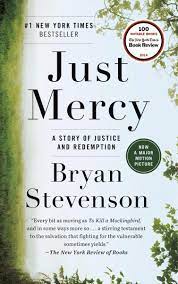One challenge in writing a book is how to structure it. Putting all the material together in a coherent package is tough. Where to start, where to finish, how to best arrange things in the middle, and what to leave out(!)—it can all be rather daunting.
In Write Better I include a chapter offering a dozen common options for organizing a nonfiction book. But there are dozens more, and when I read a new book, I am always on the alert for effective ways writers use for presenting their ideas.
 Bryan Stevenson’s Just Mercy is an important book on an important topic that also offers an interesting structure that could well work for others. The main focus is the story of Walter McMillian, an innocent man who was sentenced to death row in Alabama. His case and how Stevenson became involved is fascinating and dramatic.
Bryan Stevenson’s Just Mercy is an important book on an important topic that also offers an interesting structure that could well work for others. The main focus is the story of Walter McMillian, an innocent man who was sentenced to death row in Alabama. His case and how Stevenson became involved is fascinating and dramatic.
But every ten pages or so Stevenson pulls back from this tale and gives background information regarding related aspects of the justice system—trying minors as adults, sentencing practices in different regions, the use of solitary confinement, the political history of Alabama. These topics branch off the main trunk of the memoir like branches of a tree laden with heavy, nutritious fruit.
 Stevenson also includes flashbacks on his own story or tells how he was building his organization (as a subplot, if you will) in parallel to the McMillian case. If Stevenson had structured the book around these “side” issues, readers could have gotten glassy eyed when statistics are piled up or legal precedents are detailed. But since that information is wrapped in a compelling story—it makes all the difference.
Stevenson also includes flashbacks on his own story or tells how he was building his organization (as a subplot, if you will) in parallel to the McMillian case. If Stevenson had structured the book around these “side” issues, readers could have gotten glassy eyed when statistics are piled up or legal precedents are detailed. But since that information is wrapped in a compelling story—it makes all the difference.
In addition, that content is presented in an emotional package of his passion that we as readers get involved with, being incensed about the many outrageous stories of injustice that he tells along the way. As readers we end up caring and wondering what we can do too.
As you think about writing a book, then, consider whether or not you have a story that:
♦ you were personally involved with
♦ stretched out over a period of years
♦ had barriers and problems that needed to be overcome
♦ touches on a variety of substantive issues you are concerned about that could branch off of your main storyline, and
♦ has a narrative arc that builds tension, has setbacks, and perseveres to a resolution that gives hope
I think you could find this a very fruitful approach.
—
photo: Hans Braxmeier, Pixabay

Mr. Le Peau,
I gave my wife Just Mercy for Christmas in 2019. She quite enjoyed it. I always meant to borrow it from her. I think I’ll take this occasion to do so. I am a big fan of IVP, and my esteem for your occupation (which was high anyway) rose dramatically, when I realized you were associated with such a fine publishing house.
Thanks for the advice, Andy, and what a fun closing sentence you give us here 🙂
Andy, that’s an amazingly helpful article. Thank you!
I have everything needed, except for “a resolution that gives hope.” If no such resolution comes, by the time of publishing (Lord willing), I can certainly speak of the ultimate resolution which belongs to all who are in Christ.
Scott